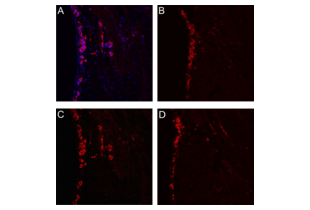S1PR1 抗体 (C-Term)
-
- 抗原 See all S1PR1 抗体
- S1PR1 (Sphingosine-1-Phosphate Receptor 1 (S1PR1))
-
抗原表位
- C-Term
-
适用
- 人
-
宿主
- 兔
-
克隆类型
- 多克隆
-
标记
- This S1PR1 antibody is un-conjugated
-
应用范围
- Western Blotting (WB), Immunofluorescence (IF), Immunohistochemistry (Paraffin-embedded Sections) (IHC (p)), Immunocytochemistry (ICC)
- 交叉反应
- 人, 小鼠
- 产品特性
-
Rabbit Polyclonal antibody to EDG1 (sphingosine-1-phosphate receptor 1)
EDG1 antibody [C2C3], C-term - 纯化方法
- Purified by antigen-affinity chromatography.
- 免疫原
- Carrier-protein conjugated synthetic peptide encompassing a sequence within the C-terminus region of human EDG1. The exact sequence is proprietary.
- 亚型
- IgG
-
-
- 应用备注
- WB: 1:500-1:3000. ICC/IF: 1:100-1:1000. IHC-P: 1:100-1:1000. Optimal dilutions/concentrations should be determined by the researcher. Not tested in other applications.
- 说明
-
Positive Control: HepG2
- 限制
- 仅限研究用
-
- by
- Memorial Sloan-Kettering Cancer Center, Parada lab
- No.
- #100014
- 日期
- 2016.05.11
- 抗原
- Sphingosine-1-Phosphate Receptor 1 (S1PR1)
- Lot Number
- 39471
- Method validated
- Immunofluorescence
- Positive Control
- Wild-type mouse adult brain cryo-sections
- Negative Control
- Rabbit IgG
- Notes
- The antibody showed signals along the subventricular zone, which is consistent with the RNA expression analysis.
- Primary Antibody
- ABIN2857018
- Secondary Antibody
- Donkey-anti-Rabbit-Cy3
- Full Protocol
- Wild-type mouse adult brain was dissected, fixed in 4% PFA for over/night, saturated in 30% sucrose, mounted in Cryo, and sectioned into 12µm sections.
- Immunostaining for Cryo Sections:
- Dry slides at 50-55°C for 15-30min (or RT for 30min).
- Wash with PBS 5min X 3 (shake gently).
- Block with 10% Normal Donkey Serum (NDS) at RT for 1h.
- Incubate with ABIN2857018 diluted 1:10 - 1:800 in 2% NDS at 4°C overnight.
- Wash with PBS 5min X 3.
- Incubate with the secondary antibody Donkey-anti-Rabbit-Cy3 together with DAPI 1:100 at RT for 1h (prepared in 2% NDS), cover the chamber with foil.
- Wash with PBS 5min X 3.
- Add three drops of water-based Immu-mount.
- Cover with 24 X 60 cover glass.
- Imaging:
- Images were taken using a Zeiss Axio2-Imaging system, 20X-0.5NA-Dry Dye-1004-072 objective, DAPI and Cy3 channel.
- Experimental Notes
- ABIN2857018 worked the best at 1:200. At 1:400, or 1:800, it seems to lose some signals in some cells.
生效 #100014 (Immunofluorescence)![成功验证 '独立验证'标志]()
![成功验证 '独立验证'标志]() Validation ImagesFull Methods
Validation ImagesFull Methods -
- 状态
- Liquid
- 浓度
- 1 mg/mL
- 缓冲液
- 1XPBS ( pH 7), 20 % Glycerol, 0.01 % Thimerosal
- 储存液
- Thimerosal (Merthiolate)
- 注意事项
- This product contains Thimerosal (Merthiolate): a POISONOUS AND HAZARDOUS SUBSTANCE which should be handled by trained staff only.
- 储存条件
- 4 °C,-20 °C
- 储存方法
- Store as concentrated solution. Centrifuge briefly prior to opening vial. For short-term storage (1-2 weeks), store at 4°C. For long-term storage, aliquot and store at -20°C or below. Avoid multiple freeze-thaw cycles.
-
- 抗原
- S1PR1 (Sphingosine-1-Phosphate Receptor 1 (S1PR1))
- 别名
- sphingosine-1-phosphate receptor 1 (S1PR1 产品)
- 背景
-
The protein encoded by this gene is structurally similar to G protein-coupled receptors and is highly expressed in endothelial cells. It binds the ligand sphingosine-1-phosphate with high affinity and high specificity, and suggested to be involved in the processes that regulate the differentiation of endothelial cells. Activation of this receptor induces cell-cell adhesion.
Cellular Localization: Cell membrane, Multi-pass membrane protein - 分子量
- 43 kDa
- 基因ID
- 1901
- UniProt
- P21453
- 途径
- Signaling Events mediated by VEGFR1 and VEGFR2
-


 (1 validation)
(1 validation)



